For the Love of Mangos – Ecuador

Curator Noris Ledesma travels to Ecuador to delve into the world of chocolate and mango along the North coast of South America. Follow her adventure through the country of emerald greens and ocean blues. She will immerse herself into the culture and business of cacao, learning the secrets of this ancient crop of the Maya and passing on the adventure to the Fairchild family. Few crops have such a rich cultural heritage or possess such commercial potential. Cacao farming of today is innovative, exciting and of course, delicious. Then it is off to the lowland coast and the land of the mango to witness the modern Ecuadorian industry racing to keep pace with the fast-changing world. Florida has had its hand in the building of the Ecuadorian industry through technology and varieties – stay tuned to learn just how influential our local mango community has been. It will be a long five days full of cultural adventure, where two crops of the ancients collide with the modern world in the shadow of the Andes.

Hacienda CAÑAS
December 15, 2009
I came into the Gulf of Guayaquil, looking for winter mangos from Ecuador. The last time I came to Guayaquil I was 15 years old – taking part in a fieldtrip from the school that I attended on the border in my native Colombia. In those days Guayaquil was quite different. I remember the riverfront of the city filled with crafts of many kinds, and vessels from great ships to dug-outs, rafts, and cargo boats used by the locals to bring their wares from the interior to the markets. Today the city has changed; Guayaquil is now Ecuador’s “second city” (it is actually bigger than the capital Quito) and they don’t have the floating market any more, it is closed due to the big ships. Life goes on.
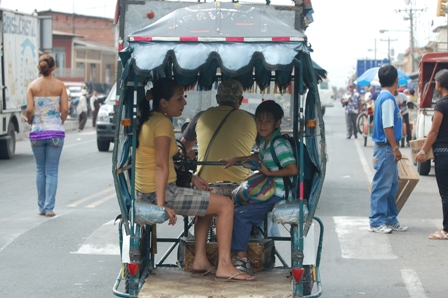
Sergio Cedeño has become a good friend and contact for the Tropical Fruit Program and Fairchild and he was there to meet me upon arrival. He is the president of INDUSTRIAL Y AGRICOLA CAÑAS C.A. and PIVANO S.A. He offered to introduce me to his company and their work with cacao and mango in Ecuador. We went first to the cacao farm, where they also grow banana and operates the biggest cacao nursery in the country.
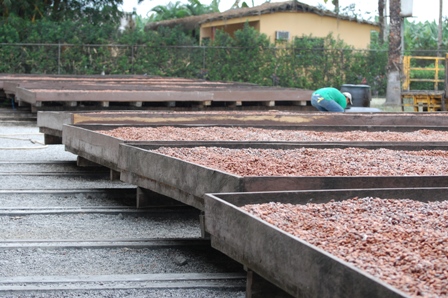
Hacienda Cañas is about 75 kilometers south of Guayaquil, near the town of Puerto Inca. A highway proudly welcomes visitors to the region (at kilometer 26) with fruit of the season. In this case there were mango vendors lining the road, nearly a full kilometer dedicated to the king of fruit. They offer the best that Ecuador has to offer in the form of ‘Edward’, ‘Tommy Atkins’, ‘Mango de Chupar’ and ‘Reina’. We stopped, we ate and we learned. Long live the king!

Arriving to “Hacienda Cañas” I enjoyed Sergio negotiating the cacao harvest for today. A single phone call did the trick and 100 pounds of nibs were sold for US$ 144. During my visit I learned much about cacao and the profits of Ecuadorian farming. This is good timing for this experience, we are preparing for one of the biggest events at Fairchild “The International Chocolate Festival” which will be in January 2010.

The native Theobroma cacao type from Ecuador, known collectively as “Nacional”, is famous for its fine cocoa flavor. From the beginning of the twentieth century; however, it has been subjected to genetic erosion due principally to successive introductions of foreign germplasm whose hybrid descendants gradually replaced the native plantations. Thus, the cocoa quality declined.
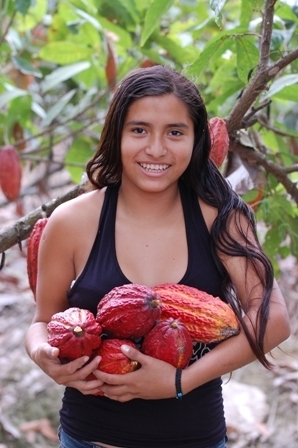
“Nacional” beans give farmers only 0.25 or 0.30 tons per hectare per year. Small farmers with one or two hectares don’t even produce half a ton, and that’s not enough to survive – then came the new hybrid CCN-51. CCN-51, also called ‘Don Homero’ was named by the breeder Don Homero Castro, who developed it in the 1970s. While it isn’t classified as a fine cocoa, it is a vigorous, highly productive plant and is readily available to cocoa farmers throughout the country. CCN-51 has a higher fat content (54%) is considerable higher yielding, more disease resistant variety of bean than any other national clones. That’s why there’s been a big shift toward planting CCN-51 which produces 2.5 tons per hectare a year. What an easy decision to make. Now all cacao farmers are replacing the “National” selections for CCN-51.

Hacienda Cañas has 800 acres of cocoa and they have grown ‘Don Homero’ for more than 20 years. December is not the peak of the season for cacao but I still had the chance to see the process from the picking to the final product. From the collection center, the beans go through the various stages of processing under thatched-roof buildings painted in rustic shades of green. If you enjoy chocolate you may have no idea just what it takes to get it all the way from bean to bar.
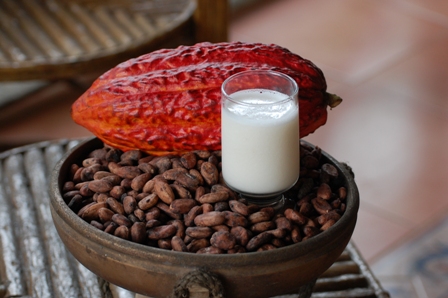
I’ve learned that cocoa production is not easy, it requires an organized path that the raw cacao takes to get all the way to your pretty foil wrapped bar or boxed bonbon in your modern country.
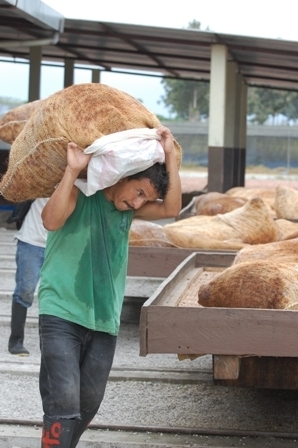
The cacao trees are handsome. They are from ten to thirty feet tall depending on the selection and the horticultural practices. The cacao fruit, which is bigger than an orange, grows close to the stem or trunk. Each fruit contains from twenty-eight to thirty seeds. The seeds are covered with a pulp that can be used for smoothies and drinks.

The laborers, working as a team, harvest the mature pods and remove the seeds in the field and then transport the seeds to a warehouse to wash off the pulp. The seeds are packed and transported for the fermentation process to a warehouse filled with the pungent aroma of fermented cacao beans. The fermentation is a really important process to guarantee the quality of the cacao.
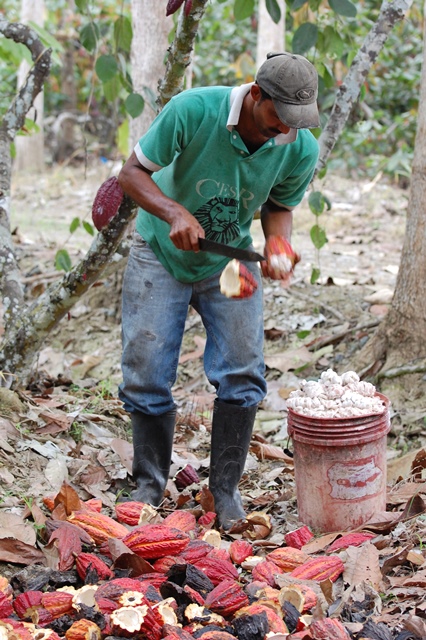
After this process the beans are dried and shipped to chocolate factories all over the world.
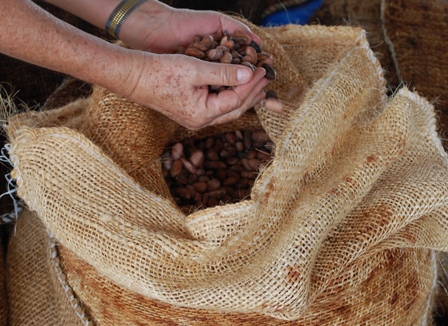
The day brought back good memories for me. And, thanks to record world prices for cocoa, there is joy all around the world of cacao. Prices are rising and are estimated to triple in the near future. These prices are fueling a revival of Ecuador’s once-proud cocoa industry — and offering hope to the hundreds of thousands of people whose livelihoods depend on the tastebuds of North American, European and Asian chocolate connoisseurs.
Ecuadorian Mangos Fill the Mexican Gap
December 16, 2009
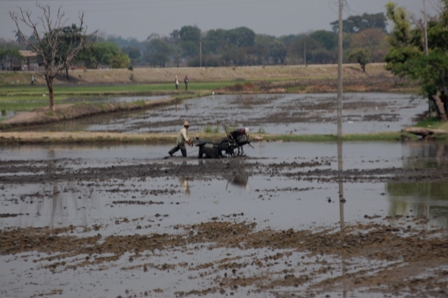
Despite Mexico being one of the largest mango-growing and consuming countries in the world, they have no local production during the October to December period, and this is when imported Ecuadorian mangos fill in the gap. Ecuador’s mango harvest begins during mid-October and ends in early February. In Ecuador, mangos are cultivated mainly in the province of Guayas, with has about 7,700 hectares in full production, of which 6,500 are dedicated to export. The remaining acreage is devoted to other markets, (local, Andean pact) or to the elaboration of juices and mango concentrate. It was this industry that I set my sights for the day.
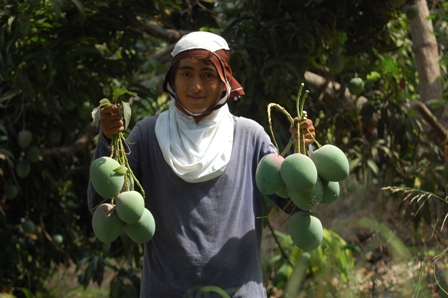
Shortly after leaving Guayaquil we passed the mouth of the Daule River, and driving north for an hour we started to see the changes in land use. In the low areas you see rice, and then plantain, teak and finally mango. En route we passed the town of Palestina, whose people were getting ready for the New Year with their colorful “año viejos” dolls. About 5 miles from Palestina we arrived at our destination, the Pivano Farm.
Pivano Farm is 450 hectares with the infrastructure and technology to export mangos. The main varieties they have are ‘Tommy Atkins’ (235 hectares), ‘Kent’ (195 hectares), ‘Keitt’ (20 hectares), and ‘Nam Doc Mai’ (12 hectares). For mangos in Guayaquil they had already harvested the ‘Tommy Atkins’, ‘Keitt’ and ‘Nam Doc Mai’.
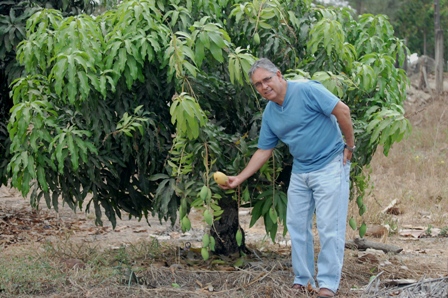
Manuel Jimenez, the Director of the orchard operations of Pivano, brought me to the farm. We stopped to see the harvesting of ‘Kent’. About 500 hard workers were climbing in the trees to pull the mangos out. Working in groups, they delegate specific jobs. One picks, others are in the orchard to transport the fruit and gently place them on trays to bleed the latex. Each mango has its stem cut with clippers and is drained of the burning latex. This allows for the marketing of a near perfect outward appearance for the fruit. Then it is off to the packinghouse.
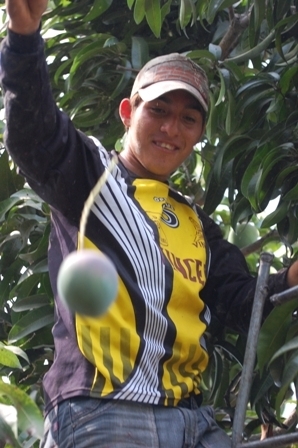
Ing. Jimenez showed me with pride their ‘Nam Doc Mai’. ‘Nam Doc Mai’ is a Thai selection that produces yellow mangos and a few innovative Ecuadorians are giving it a try as a new product for the United States. The material for this orchard originated from budwood sent by Fairchild Tropical Botanic Garden a few years ago. It was a great pleasure to see the fruits of our labors at FTBG. Only time will tell if the ‘Nam Doc Mai’ can withstand hot water treatment and long distance transport to the United States.
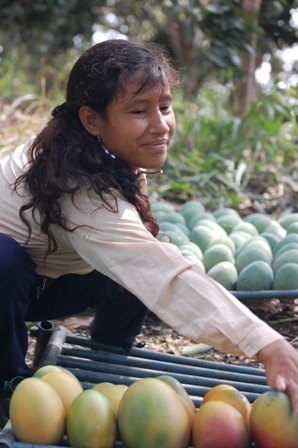
After lunch I had a meeting with Mr. Santiago Maspons, the owner of the company, to discuss the future of mangos in Ecuador. Ecuador faces an oversupply situation when competing with Brazil and Peru in international markets. Of the three countries, Brazilian mango growers are always first into the market, followed by Ecuador and then Peru.
Peru’s mango production is 50 percent bigger than Ecuador’s, but because a large portion of Peru’s mangos are exported to Europe, the neighboring countries export about the same volume to the United States. Virtually all Ecuador’s mangos are exported to the United States because of the fast sea transportation links.
After the meeting Ing Sergio Cadeno and his wife invited me to a reception for the launching of the new book “The Banana Production in Ecuador”. Many of the biggest players of the banana were there. A good time was had by all and another day’s adventure came to a close.
Pivano and Tulicorp
Thu, Dec 17, 2009 at 10:29:48 AM
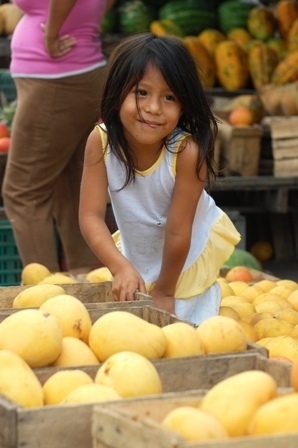
In the morning I made a short visit to the fruit market close by the hotel. I was impressed by the clean and overall well-presented market. The mayor of Guayaquil renovated all the markets in the city last year – what a difference. The mayor also has been investing to renovate and create more green areas for the Guayaquileans. Many new and renovated parks bordered the rivers throughout the city; there was beautiful landscaping, open green spaces and in a word, quality of life.

Then it was on to the mangos and the Pivano packinghouse. This is where the mangos are received, washed, sorted and bathed in hot water for export to the United States. Arriving at the packinghouse, I meet with Ing. Elsa Alsaro from Piura, Peru. She is a consultant for the Ecuadorian company. She showed me all the process and the challenges she is confronting to get mangos to the United States with the best quality possible.
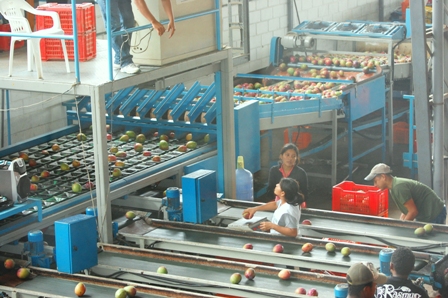
The mangos in the Guayaquil area are under monitoring for fruit flies in the field. This monitoring is designed to reduce the number of fruit fly that infect the fruit. Fields are certified for export and only fruit from these fields are allowed to be exported. Even with the monitoring and certification the fruit must go through a hot-water treatment to meet USDA phytosanitary regulations. The fruit exported to the United States must pass through the Hot Water Quarantine Treatment to kill any fruit fly larva or mature insects. The fruit are submerged in 115°F water for about an hour. If done properly the quality is not negatively affected. Proper hot water treatment is one of the biggest challenges facing the Ecuadorean industry.

After this, the mangos are polished, packed and stored at 50F to hold their maturation until they arrive at the final destination. Any fruit that cannot be exported (too big, cosmetic blemishes, etc.) are sent to other markets, local or to the elaboration of juices and mango concentrate. The packinghouse is the key control point of quality for any export industry, for once a fruit is harvested from the tree everything must be done to safeguard quality. This is the challenge.

Before leaving Guayaquil I went back to the world of chocolate with a visit to Tulicorp corporation – a local confectionery manufacturer. Mr. Eduardo Marquez de la Plata, Marketing director of the company educated me about quality of chocolate. Cacao has been his life and he speaks from his heart. Eduardo loves cacao, this much is clear. “Flavor, aroma and color come from the soil than cacao grows, the essence of the land will express better their genes” he said. “Some varieties have better quality. The ultimate flavor comes from the combination of land, variety and the proper handling of the beans during the fermentation process”, explained Eduardo.
My journey in Ecuador finished, I returned to the hotel to write down my thoughts and to offer thanks to my hosts. I want to thank HACIENDA DE CACAO CAÑAS C.A. and PIVANO S.A., Ing. Sergio Cedeño and his team for this opportunity. This was my first visit as a professional to Ecuador. What I found was a business environment based on a love for the product. Cacao runs in the blood of the people of this region. The mango too has taken hold in these soils. The mango now works her magic on the people. Unlike cacao, the mango industry is struggling from a business sense. In the years to come we hope to help our friends to answer the challenge.
